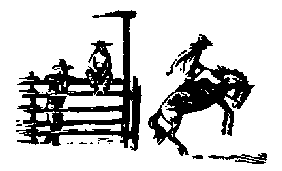




Next: The Flat Loop Up: The Lasso Previous: List of Figures
Please Read The Copyright Notice





Next: The Flat Loop
Up: The Lasso
Previous: List of Figures
I first became seriously interested in trick roping in August of 1985 when I saw a copy of Frank Dean's book Will Rogers' Rope Tricks [4]. Using this book as my guide I worked hard trying to learn the different tricks but my progress was slow and frustrating. Since I thought that a more visual approach might be helpful I started looking for the film from which many of the photos in Dean's book were taken. This film, called The Roping Fool, was a black and white made in 1925 [12]. My search for it was literally from coast to coast. I called film libraries in New York, Washington DC, California, and even the Will Rogers' museum in Claremore, Oklahoma. After many months of searching I succeeded in tracking down a copy of it. Ironically it had been waiting for me all this time at a small film distribution company not 20 miles from where I lived.
Will Rogers' film helped, however, the master keys to understanding most
of the tricks seemed to remain just outside of my grasp.
As time went by I had the good fortune to meet some talented trick ropers
such as Vic Shore, Vince Bruce, and
Serge Holtz to name a few. These ropers
were very generous with their time and their advice. Nevertheless, even
with the book, the film, and the good advice it seemed that
the secret to learning each trick could only be discovered one way
 by lots of hard work and a lot of trial and error!
by lots of hard work and a lot of trial and error!
Curiously, as I slowly succeeded in learning tricks, I began to realize that most of them are not difficult once you know the secret. So why were they so hard to learn? The answer is that the physics of the lasso is based on rotational mechanics and most people don't have a good feel for how rotating objects react. I began to try and identify the different principles that each lasso trick depended on. As my catalog of principles grew I discovered that I could apply them to tricks I hadn't already mastered and that this greatly accelerated my learning curve.
Over the years I've taught trick roping to many people and I feel that my knowledge of the underlying physical principles has greatly aided my students to more rapidly learn lasso tricks. The objective of this book is to describe these principles in an intuitive way. Don't worry you won't have to be a rocket scientist to understand them! Once you're familiar with them you'll have the know-how to learn any lasso trick.
This book takes an original approach to learning trick roping. The method is not just descriptive since the explanation of the underlying physical principles describes dynamic aspects of the lasso which are otherwise not readily apparent. This knowledge of the dynamics greatly leverages the learning process. Of course understanding the physical principles of the lasso doesn't translate directly into being able to do the tricks. Nevertheless, knowing about how tricks should work is like knowing about certain landmarks that you expect to see on the way to a new destination. If you don't see the landmarks you start to suspect that you are no longer on the right path. The principles of the lasso are similar since they provide a point of reference that can help you decide whether or not you are practicing in the right way. This book explains the underlying principles of the lasso and this in turn provides landmark information on the road map to trick roping.
Although, the number of books on the lasso is not legion there are some other resources available. You will find a pretty complete list in the references at the end of this book. Of particular interest is the book by Clare Johnson entitled How to Trick Rope [8] which is the most complete compendium of lasso tricks available. Also listed in the references are the names and addresses of suppliers of roping equipment [1], [9]. If you need to buy rope or want a lasso ready-made you'll be able to buy them here. They also offer a selection of books and videos on roping as well as on a wide variety of other interesting western and circus skills.
It is my hope that this book will provide insights into trick roping and aid others interested in learning this wonderful art from the wild west days. Since this book is the product of desktop publishing it's easy to revise and I'm interested in improving it. In this perspective your comments and ideas are of great interest to me. Is there a part of this book that you don't understand? Is there a part you think is well done? Send me your questions, criticisms, and kudos! They can be addressed to Carey Bunks , 220 Commonwealth Ave., Boston, MA 02116, USA (or for those of you who have a connection to the Internet you can send e-mail to cbunks@bbn.com). If you let me know that you have a copy of the book I'll try to keep you informed on revisions. Hope to hear from you, and have fun roping!





